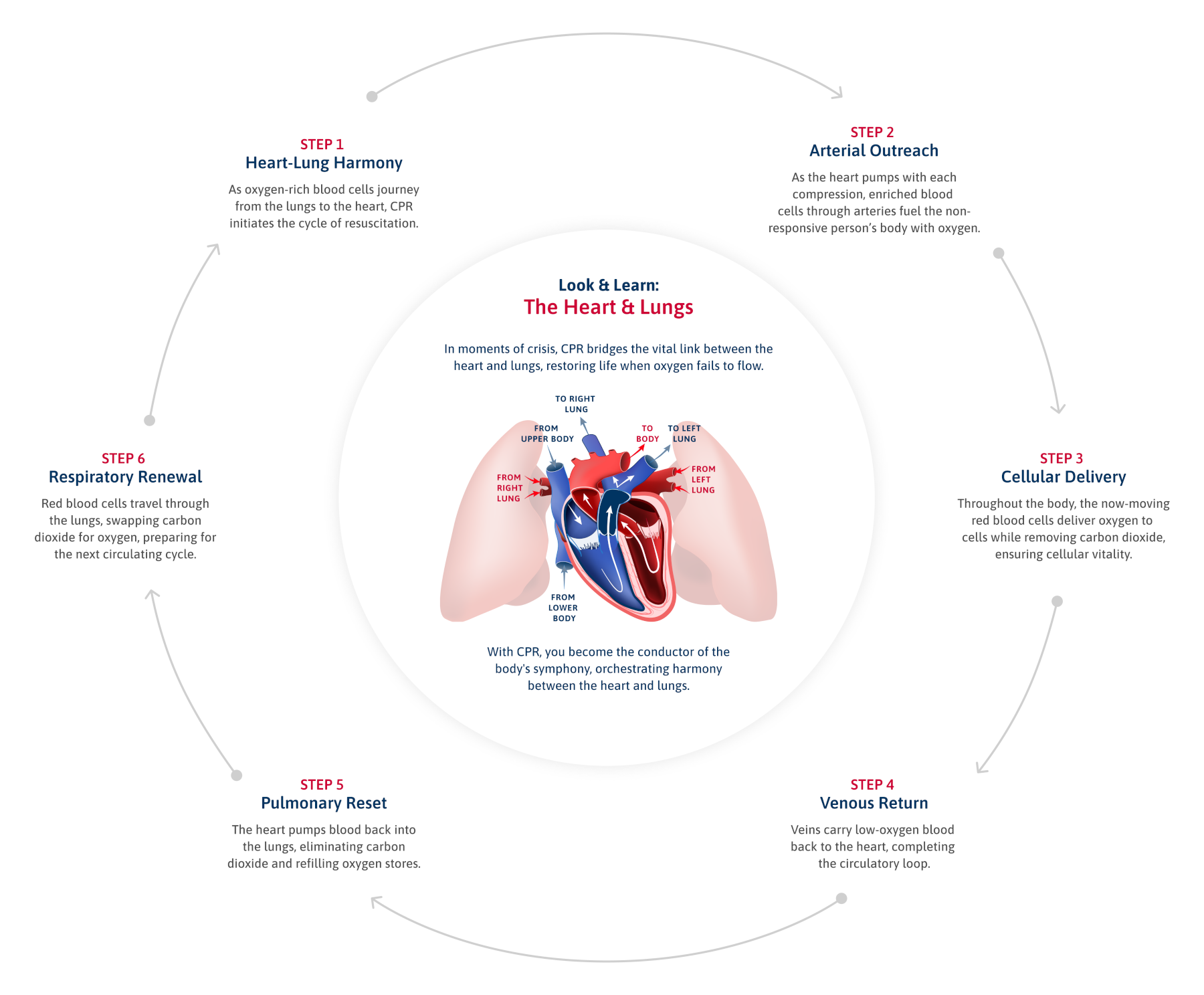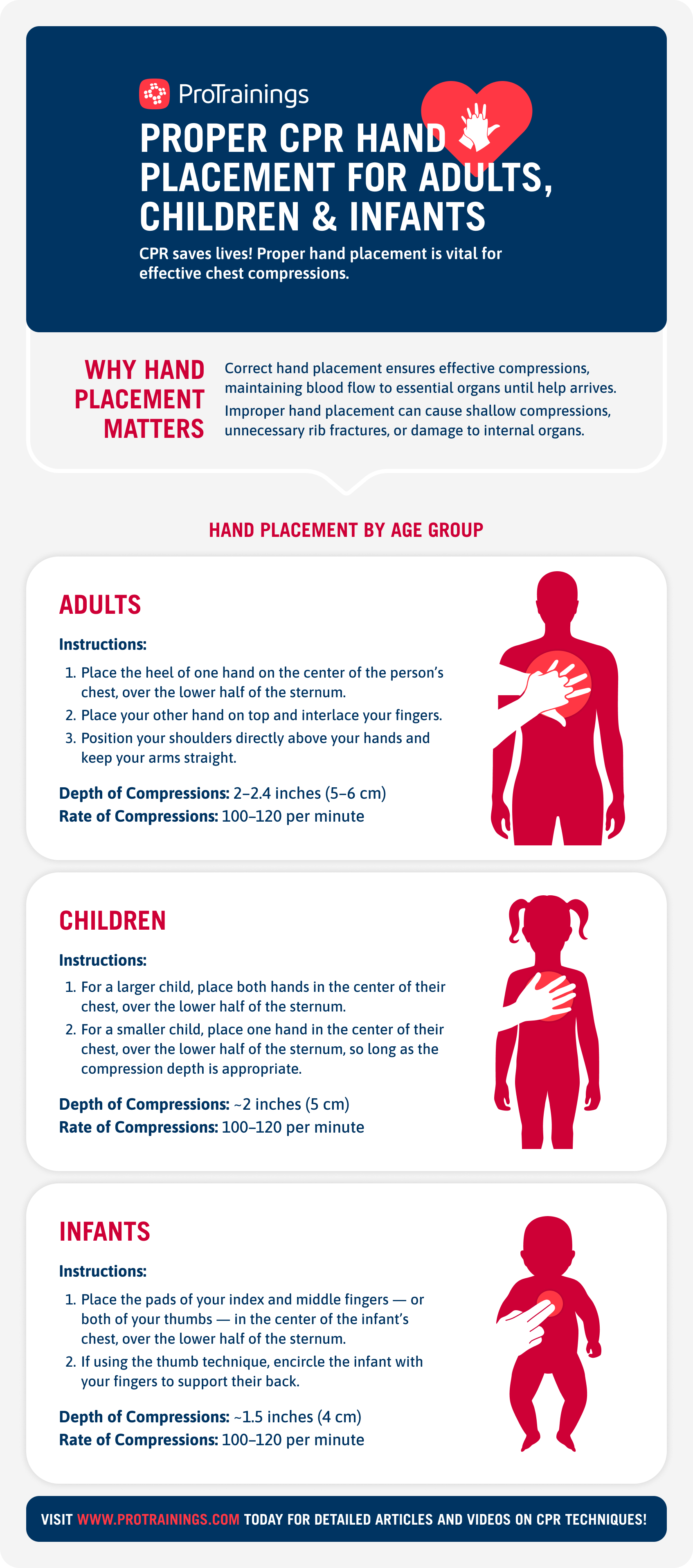Table of Contents
- Intro
- Why Does Hand Placement Matter
- What Is the Correct CPR Hand Placement for Each Age Group?
- Does CPR Hand Placement Differ for Men and Women
- What Else Do I Need to Know About CPR?
During a medical emergency, performing CPR on a victim until emergency assistance arrives is vital. Although the concept of CPR is simple, a few key elements — like CPR hand placement — can help give the victim the best chance of survival.
While it may seem like a minor detail, hand placement for the most effective CPR administration varies depending on the victim’s age.
Hand placement for the most effective CPR administration varies depending on the victim’s age.
According to the Journal of the American Heart Association, there are over 632,000 cardiac arrest events in the United States each year. This number is staggering, but you can be prepared in the face of an emergency by learning how to properly perform CPR.
Here, we explain all you need to know about CPR hand placement for different age groups and why hand placement is so important when performing CPR.
Why Does Hand Placement Matter?
Proper CPR hand placement maximizes the chances of survival for someone experiencing cardiac arrest. Correct hand placement ensures effective chest compression, which is essential for maintaining blood flow to vital organs.

The primary goal of CPR is to simulate a heartbeat. The rescuer manually pumps blood through the victim’s body by applying compressive force with their hands. This circulation delivers the necessary oxygen to vital organs, such as the brain and lungs. Without adequate oxygen, these organs can start to fail within minutes.
Proper hand placement is crucial for effective CPR, ensuring compressions are performed correctly.
Refining CPR Hand Placement
CPR hand placement saw significant advancements in the 1970s. During this period, the technique was notably refined with Dr. Henry Heimlich’s introduction of the Heimlich maneuver.
Although the Heimlich maneuver was primarily designed for relieving choking, its introduction marked a pivotal shift in emergency care practices. Dr. Heimlich’s method of abdominal thrusts for obstructed airways became widely adopted, influencing the emergency response field on a broader level, including CPR.
When hands are placed in the center of the chest, they facilitate the delivery of consistent and effective compressions, which help stimulate the heart’s pumping. This maintains blood flow to vital organs until medical professionals arrive on the scene and supports the recommended compression depth and rate.
Have a look at how chest compressions affect the heart and lungs during CPR in our infographic.

There’s a common myth that the heart is positioned far to the left side of the chest, but in reality, it is centrally located, with only a slight tilt to the left. To perform effective CPR, place your hands on the lower half of the sternum (the flat, vertical bone in the center of the chest), where the heart is centrally situated.
It’s important to remember that improper hand placement increases your chance of causing unnecessary injuries.
The Risks of Improper Hand Placement
Improper hand placement during CPR can significantly undermine the effectiveness of the life-saving procedure. If the hands are positioned incorrectly, compressions may be too shallow, leading to inefficient blood circulation and a reduced chance of successful resuscitation.
Incorrect hand placement can also increase the risk of causing further harm to the victim — such as rib fractures or breaking the xiphoid process, which can lead to unnecessary damage to internal organs. This not only complicates the victim’s condition but also detracts from the overall effectiveness of the CPR being administered.
However, effective CPR requires more than just placing your hands on the person’s chest and performing chest compressions. The specific location of your hands varies depending on the victim’s age and size.
What Is the Correct CPR Hand Placement for Each Age Group?
If you prefer to start with a visual guide, check out our infographic on the proper CPR hand placement for a specific age group.

Correct CPR hand placement depends on whether the victim is an adult, a child, or an infant.
Knowing the right hand placement is essential for the safety of the victim on whom you’re performing chest compressions.
The adjustment of your approach based on the victim’s age is an important skill for anyone trained in CPR.
For Adults
When performing CPR on an adult, proper hand placement is essential for delivering effective compressions.
- Begin by placing the heel of one hand in the center of the chest, specifically on the lower half of the sternum.
- Position the other hand on top of the first hand, interlacing your fingers to stabilize your grip. Your shoulders should be directly above your hands to ensure that you apply straight, downward force.
- Keeping your arms straight and elbows locked will help you achieve the required depth of compression (at least 2 inches) and maintain the recommended compression rate of 100–120 per minute.
Watch the video below to learn more about hand placement for performing CPR on adults!
For Children
For children aged one year to early teens, the technique for CPR hand placement can vary depending on the child’s size and the rescuer’s strength.
- For smaller children, use one hand. Position the heel of the hand in the center of the chest, over the lower half of the sternum, and use your body weight to deliver compressions.
- For larger children, or when more force is needed, use both hands to provide deeper compressions.
- The appropriate depth of compression for children is one-third the depth of the chest (about 2 inches).
Emergencies can happen quickly when it comes to children. Be confident and prepared with our children’s CPR video!
For Infants
When performing CPR on infants under one year old, it’s important to use a gentler technique to avoid causing injury.
- Place the pads of your index and middle fingers in the center of the infant’s chest, over the lower half of the sternum.
- Applying gentle but firm pressure, perform compressions at one-third the depth of the chest, or about 1.5 inches deep.
We know performing CPR on an infant can be intimidating, so we created a video for you to get a better understanding of the technique.
Correct hand placement is critical for the effectiveness of CPR and for minimizing the risk of injury to the victim. By understanding and applying the appropriate technique for each age group, you can enhance the effectiveness of CPR and improve the chances of a successful resuscitation.
Does CPR Hand Placement Differ for Men and Women?
No. CPR hand placement guidelines are the same for both men and women.
Interestingly, a survey by the American Heart Association reported women as less likely to receive CPR from bystanders. It also found that rescuers are more afraid of harming a female victim, more likely to think a female victim is just “being overdramatic,” or more worried about being accused of inappropriate touching or sexual assault.
Whatever the gender of the victim, it’s important to administer CPR as soon as possible to minimize damage to the vital organs.
What Else Do I Need to Know About CPR?
Proper hand positioning is not the only thing to know about CPR. Knowing which type of CPR to provide, how to give compressions at the correct speed and depth, and how to use an AED are also important for a successful rescue attempt. You should also have an understanding of the recovery position.
The recovery position is a specific technique used in first aid to help maintain an open airway and prevent choking or aspiration in individuals who are weak or not responsive but have a pulse and are breathing adequately. This position ensures their airway remains clear from fluids and the tongue while waiting for professional medical help.
Explore more about the CPR recovery position with our step-by-step video.
Knowing the best course of action is not always easy in an emergency. Educating yourself on correct CPR hand placement techniques means you’re that much more prepared for a real-world cardiac emergency.
For a detailed guide on performing CPR, visit our blog dedicated to CPR techniques or memorize the helpful mnemonic in our infographic!

Contact us today to learn more about administering safe and effective CPR and to find out how we can expand your workforce’s knowledge of CPR.
